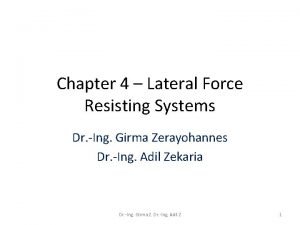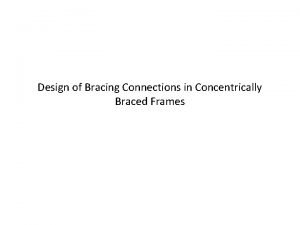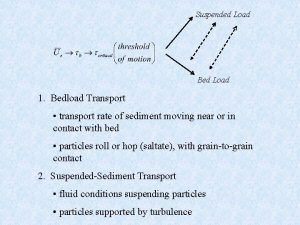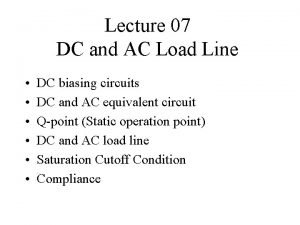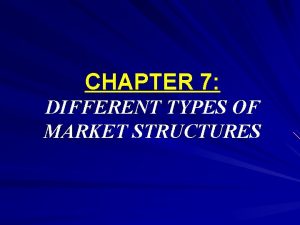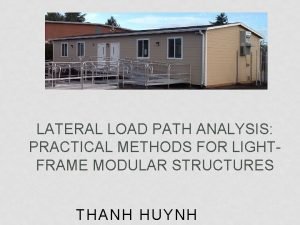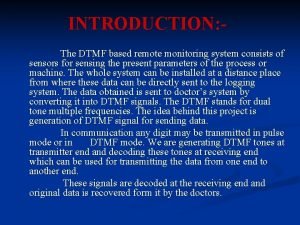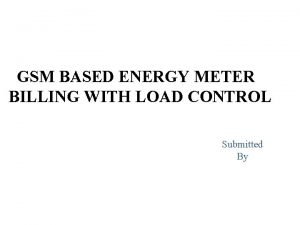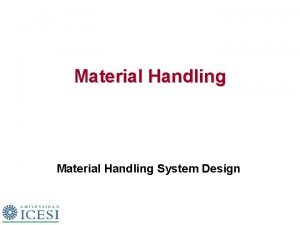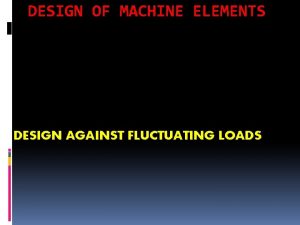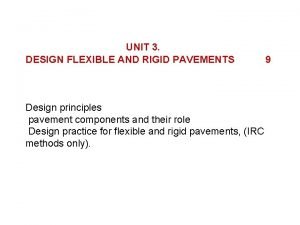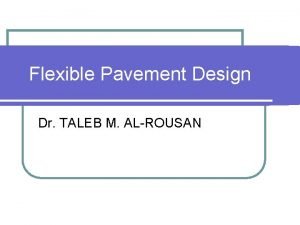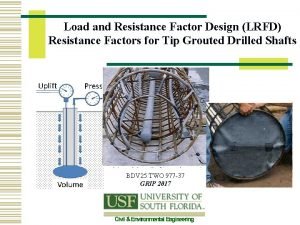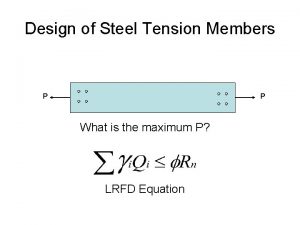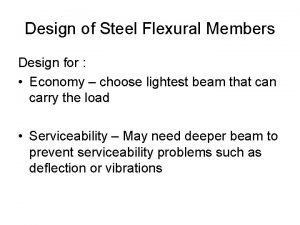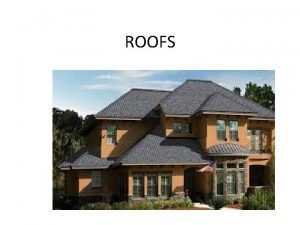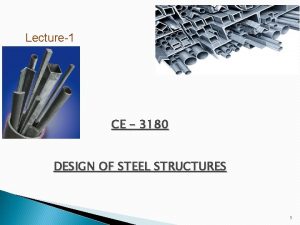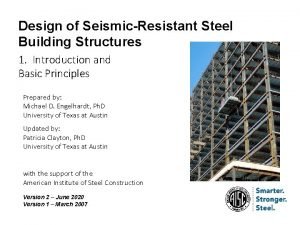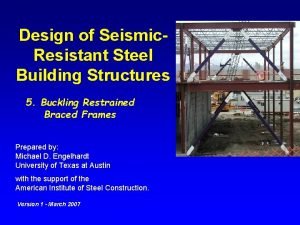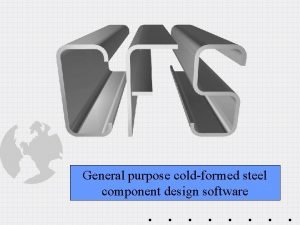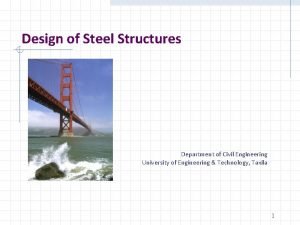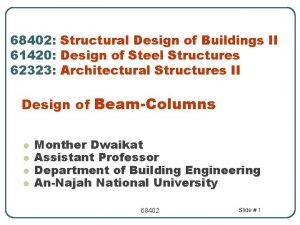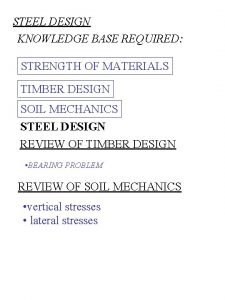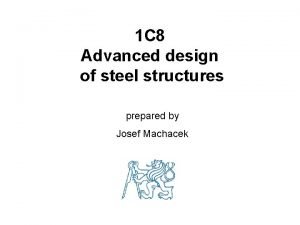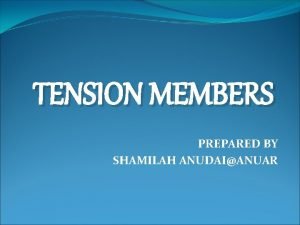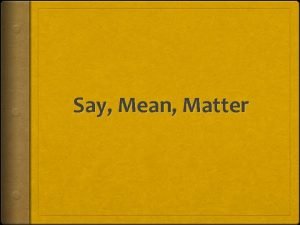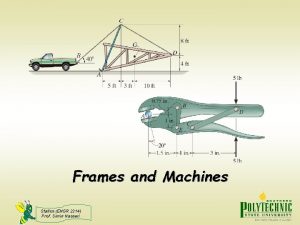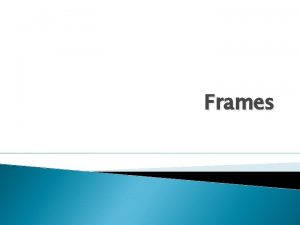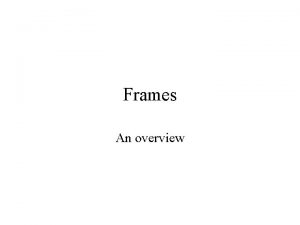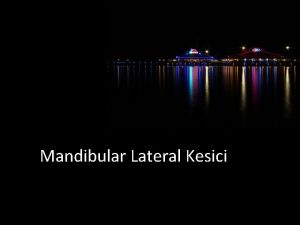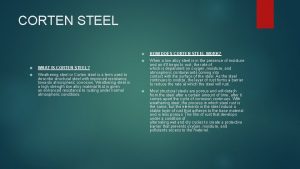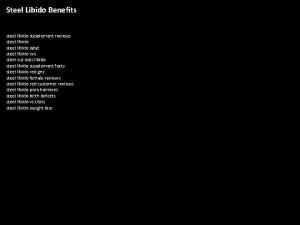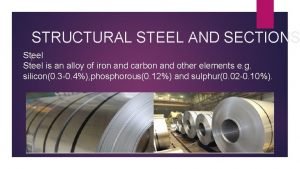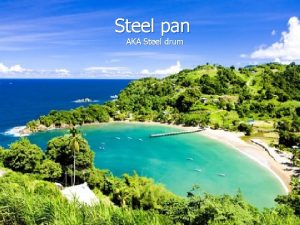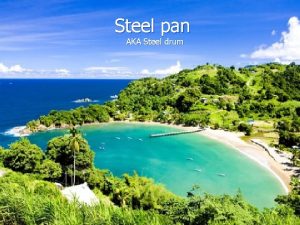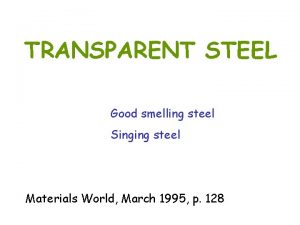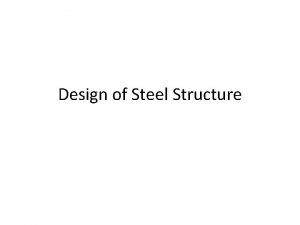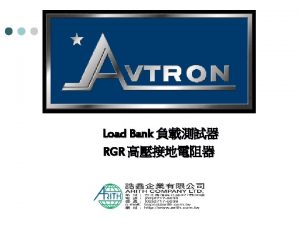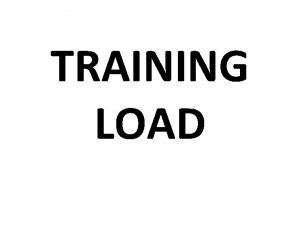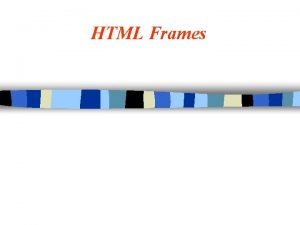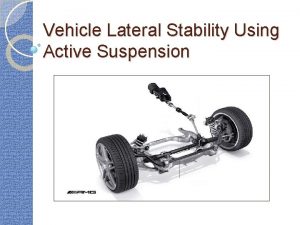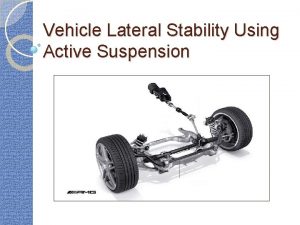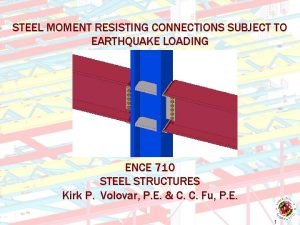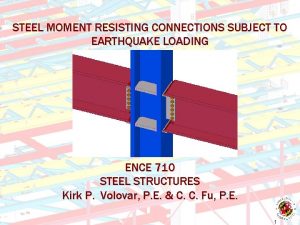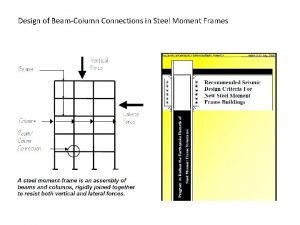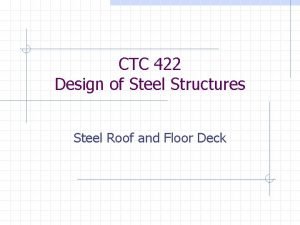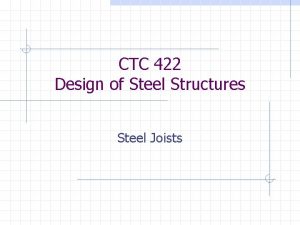Design of Lateral Load Resisting Frames Using Steel
















































- Slides: 48

Design of Lateral Load Resisting Frames Using Steel Joists and Joist Girders Authored by James M. Fisher, Ph. D. , P. E. Perry S. Green, Ph. D. Joseph J. Pote, P. E. Presentation by: James M. Fisher, Ph. D. , P. E. Vice President Computerized Structural Design Milwaukee, WI 1

Technical Digest 11 2

Technical Digest No. 11 • The purpose of TD No. 11 is to present information to the EOR, and the joist manufacturer, for the design of single story moment resisting joist and Joist Girder frames. • Design considerations for both wind and seismic lateral loads are presented. 3

Technical Digest No. 11 • The digest has been limited to single story frames, not because of wind requirements, but because of current requirements for seismic design; in particular, the use of strong beam, weak column systems which are typically necessary when using truss construction in lieu of beams and girders. 4

Technical Digest No. 11 • The Digest illustrates procedures to: – Analyze, – Design, and – Specify joist and Joist Girder moment frames to resist wind and seismic lateral loads. • The reader is assumed to be familiar with: – 2005 AISC Specification for Structural Steel Buildings – 2005 AISC Seismic Provisions for Structural Steel Buildings – ASCE 7 -05 5

Technical Digest No. 11 • Designing joist and Joist Girder structures as rigid frames is no more difficult than designing rigid frames with wide flange beams and columns. • To obtain a cost effective design the engineer must be aware of the inter-relationships between framing elements, i. e. joists, Joist Girders, columns, bracing members and connections. • In general, the most economical design is one which minimizes manufacturing and erection costs, and one which reduces the special requirements (seat stiffeners, chord reinforcing, etc. ) for the joists, Joist Girders and columns. 6

Design Methodology • The first consideration relative to the design of the structure is to determine if rigid frame action is required. • For single story structures the optimum framing system generally consists of braced frames in both directions, and the use of a roof diaphragm system to transfer wind and seismic loads to the vertical bracing elements. 7

Design Methodology • The specifying professional and the joist manufacturer must communicate design data and information to each other. • The specifying professional must specify the necessary loading and stiffness data to the joist manufacturer. • The specifying professional must indicate the type of joist to column connections so that the joist manufacturer can provide the joists with the geometry that meets the design intent. • Dialog must occur between all involved parties prior to final pricing and design. 8

Design Methodology • The joist manufacturer must design the joists in conformance with the SJI Specifications and other contract requirements specified by the specifying professional. 9

Analysis Requirements • Forces and moments in single story joist rigid frames are determined in a manner similar to other Ordinary Moment Frames (OMF). • The first step is to perform a preliminary analysis. • In general, it is suggested that the OMF be considered as a pinned based frame to eliminate moment resisting foundations; however, for drift control partially restrained or fixed bases can be considered. 10

Analysis Requirements • After selecting trial member sizes for the columns and joists, a computer analysis is performed to determine forces, moments, and deflections (both first-order and second-order) for the load combinations prescribed by the Applicable Building Code. • Because a second-order analysis is a non-linear problem, the analysis must be performed for each required load combination. 11

Frame Model for IBC or ASCE Load Combinations 12

Analysis Trial joist stiffness can be obtained from the SJI equations for the approximate moment of inertia for a joist or a Joist Girder. The SJI equation for a Joist Girder equals 0. 018 NPLd (LRFD), and 0. 027 NPLd (ASD) where: N = number of panel points P = panel point load (kips) at factored load level for LRFD, and at nominal load level for ASD L = girder length (ft. ) d = girder depth (inches) 13

Analysis The SJI equation for the approximate moment of inertia for a joist equals 26. 767(WLL)(L 3)(10 -6) for both LRFD and ASD. where: WLL = The RED figure in the K-, LH-, and DLH-Series Load Tables L = (Span – 0. 33) in feet for K-Series joists L = (Clear span + 0. 67) in feet for LH- and DLH-Series joists 14

Analysis Angle Size Unbraced Length feet L=4 L=5 L=6 L=7 Area in. 2 2 L 6 x 1 939 911 879 842 22. 0 2 L 6 x 7/8 828 809 781 749 19. 5 2 L 6 x 3/4 705 698 678 650 16. 9 2 L 2. 5 x 3/16 49 48 41 34 1. 80 15

Frame Model for AISC-Strong Beam, Weak Column 16

OMF Analysis 17

Pseudo Columns 18

Typical Connections 19

Basic Connection 20

Eccentricity Effect 21

Added Reinforcing 22

End Plate Type Connection 23

Plate Connection-Sidewall 24

Plate Connection-Interior 25

Specification of Required Forces and Moments • IBC LRFD load combinations are used. • Nominal loads: § D = 15 psf § L = 20 psf (reducible) § S = 5 psf § W (uplift gross) = 27. 25 psf (windward roof) = 17. 3 psf (leeward roof) 26

Specification of Required Forces and Moments • Seismic Criteria: § R = 3. 5 for OMF § SDS = 0. 9297 g § SD 1 = 0. 39 g § r = 1. 0 § QE = 49 kips • Imin = 6790 in. 4 for the exterior girders and 4570 in. 4 for the interior girder (analysis requirements). • Minimum width of top chord = 7. 0 in. (weld requirements). 27

Specification of Required Forces and Moments • Minimum thickness of bottom chord = 3/8 in. (weld requirements). • All top chord axial loads and end moments are transmitted directly into the columns via the tie plates. No horizontal forces are transferred through the girder seats. • Chord splices must conform to the requirements of the 2005 AISC Seismic Provisions, Section 7. 3 a. • Controlling IBC Load Combinations are given below for Joist Girder Mark Numbers G 1 and G 2, respectively: 28

Controlling IBC Load Combinations Mark G 1 LRFD Load Combination: + + Panel Load (kips) Left End Moment (kip-ft. ) Right End Moment (kip-ft. ) TC Force (kips) + BC Force (kips) Remarks 1. 4 D + 1. 4 C 1. 2 D + 1. 2 C + 1. 6(Lr or S) 1. 2 D + 1. 2 C + 1. 6 W + 0. 5(Lr or S) 1. 2 D + 1. 2 C + 1. 0 E +0. 2 S (1. 2 + 0. 2 SDS) (D+C) + QE + 0. 2 S 0. 9 D + 1. 6 W 29

Main Wind Force Resisting Pressure Table 30

2005 AISC Seismic Provisions Section 5. 1 • • Designation of the seismic load resisting system (SLRS) Designation of the members and connections that are a part of the SLRS Configuration of the connections Connection material specifications and sizes Locations of demand critical welds Locations and dimensions of protected zones Welding requirements as specified in Appendix W, Section W 2. 1 31

Controlling IBC Load Combinations Mark G 1 LRFD Load Combination: Panel Load (kips) Left End Moment (kip-ft. ) Right End Moment (kip-ft. ) TC Force (kips) BC Force (kips) Remarks (1. 2 + 0. 2 SDS) (D+C) + QE + 0. 2 S (L-R) (1. 2 + 0. 2 SDS) (D+C) + QE + 0. 2 S (R-L) (0. 9 – 0. 2 SDS)D + QE (L-R) (0. 9 – 0. 2 SDS)D + QE (R-L) Column Mp, (AISC OMF Criteria) 32

Bracing 33

Examples 1 and 2 34

Examples 1 and 2 35

Example 1 • The building is located in Charleston, South Carolina. The building code to be used is 2006 International Building Code (IBC 2006). • The precast concrete shear walls at the north and south ends of the building are non-load bearing shear walls, and are used to resist the forces between the first interior rigid frame and the end wall. 36

Example 1 Loading requirements are specified as: Roof Loads: Dead Load: 1 psf Membrane 2 psf Deck 2 psf Insulation 3 psf Joists and Bridging 2 psf Girder 10 psf Total 37

Example 1 Collateral Load: 3 psf Sprinkler 2 psf Mechanical & Lighting 5 psf Total Live Load: 20 psf Reducible per Code (12 psf on Joist Girders) Ground Snow Load = 5 psf Roof Snow Load = 5 psf (ASCE 7, Section 7. 3, low slope roof criteria) 38

Example 2 • Wind Load = 120 MPH – Exposure C • Seismic Load: Charleston, South Carolina • Serviceability Requirement: – Maximum drift = H/100 (10 year wind) 39

Examples 1 and 2 Comparison • Example 1: Charleston, SC – Wind Base Shear (120 mph) • 22. 9 kips per frame line (Factored by 1. 6) – Seismic Base Shear (R=3. 5) • 49. 0 kips per frame line • Example 2: Jackson, MS – Wind Base Shear (120 mph) • 22. 9 kips per frame line (Factored by 1. 6) – Seismic Base Shear (R=3. 0) • 14. 3 kips per frame line 40

Example 1: Exterior Columns 41

Example 1: Interior Columns 42

Example 2: Exterior Columns 43

Example 2: Interior Columns 44

Examples 1 and 2 Comparison • Example 1 (120 mph, SDC D) – – Columns: Exterior W 18 x 86, Interior W 18 x 97 Total Column Weight = 12, 200 lbs Girder Weight = 6, 300 lbs Total Weight = 18, 500 lbs per bay • Example 2 (120 mph, SDC B) – – Columns: Exterior W 21 x 111, Interior HSS 8 x 8 x 3/16 Total Column Weight = 8700 lbs Girder Weight = 3200 lbs Total Weight = 11, 900 lbs per bay 45

Appendix A • Appendix A contains a complete design of the Joist Girders for Example 1 46

Acknowledgement • The authors of Technical Digest 11 would like to thank: – The Engineering Practice Committee and the Research Committee of the Steel Joist Institute for their review and contributions to the writing of this document. – John A. Rolfes, S. E. , P. E. Vice President of Computerized Structural Design for his assistance in the preparation of the digest, and James O. Malley, S. E. Senior Principal, Degenkolb Engineers, for his insightful review of the digest. 47

Thank you 48
 Lateral force resisting system
Lateral force resisting system Bracing connection design
Bracing connection design Resisting pressure definition
Resisting pressure definition Jayakar committee
Jayakar committee Resisting temptation lds
Resisting temptation lds Efficient video classification using fewer frames
Efficient video classification using fewer frames Axial load and radial load
Axial load and radial load Red dot
Red dot Pux
Pux The point of intersection of dc and ac load lines is called
The point of intersection of dc and ac load lines is called Monopolistic company examples
Monopolistic company examples Lateral load path
Lateral load path What is ph in math surface area
What is ph in math surface area Load control system using dtmf
Load control system using dtmf Power meter billing plus load control using gsm
Power meter billing plus load control using gsm Unit load handling systems
Unit load handling systems What is notch sensitivity factor
What is notch sensitivity factor Rigid vs flexible pavement
Rigid vs flexible pavement Standard axle load for pavement design
Standard axle load for pavement design Design against fluctuating load
Design against fluctuating load Mkdhakal
Mkdhakal Aashto lrfd 2017
Aashto lrfd 2017 Concrete technology
Concrete technology Gross section yielding
Gross section yielding Flat roof steel truss
Flat roof steel truss Example of flexural member
Example of flexural member Tie beam in roof
Tie beam in roof Working stress method and limit state method
Working stress method and limit state method Site class seismic design category
Site class seismic design category Design of seismic-resistant steel building structures
Design of seismic-resistant steel building structures Bar joist
Bar joist Cold formed section software
Cold formed section software Steel structure design
Steel structure design Steel structure design
Steel structure design Steel design
Steel design Advanced design of steel structures notes
Advanced design of steel structures notes Design of tension members in steel structures
Design of tension members in steel structures What is author's purpose
What is author's purpose The four frames of kindergarten
The four frames of kindergarten Sue palmer explanation text
Sue palmer explanation text Impersonal recount
Impersonal recount What are the 4 frames in kindergarten?
What are the 4 frames in kindergarten? Instruction text
Instruction text Mean say matter
Mean say matter Sentence frames for evidence
Sentence frames for evidence Reading frame
Reading frame It's called a changeover the movie goes on
It's called a changeover the movie goes on Models of ltm - frames
Models of ltm - frames Statics frames
Statics frames
